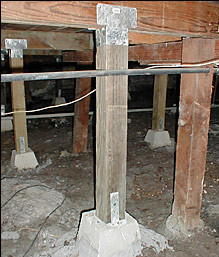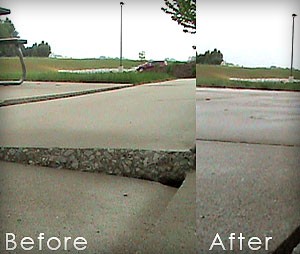BUILDERS PIERS
Builders piers are poured before the foundation is laid at a spacing of 4-8 feet apart and can be as shallow as 3-4 feet deep. The piers were designed to assist in holding the grade beam in place. Due to their low level of placement, it is not uncommon for builders piers to fail to support the structure. Therefore, additional pressed pilings may be necessary to stabilize movement. Sometimes the piers are attached to the foundation. If so, they may need to be severed (at an additional cost) in order to lift the foundation during repairs.
DRILLED PIERS
A drilled pier consists of a reinforced concrete section cast-in-place against permanent steel casing. Common types include bell bottom or straight shaft.
FOOTING
The supporting base or groundwork of a structure, as for a monument or wall. Also referred to a footer or shallow pier.
DIFFERENTIAL SETTLEMENT
We use the term “differential settlement” to describe a condition in which one portion of a building foundation is moving down, at a different rate or in a different amount from other portions of the foundation or wall.

INTERIOR PIER
When a slab foundation has settled an excessive amount and the elevations inside the home must also be raised it may be necessary to install interior piers. The piers are ideally placed under an interior beam support. Depending on the original construction, they may be placed under a section of steel angle iron directly under the slab. After the pier is installed the concrete is patched and the homeowner can replace the flooring covering the patch.
PRESSED CONCRETE PILING
The pressed piling method utilizes a series of precast concrete cylinders that are driven into the soil using the weight of the commercial building or home. The driven piles will reach a point where they can’t be driven any further with the weight of the building structure. This is called the refusal point. Once a piling has reached refusal, it becomes a stable platform from which a hydraulic jack can be used to raise a foundation.
POST TENSION SLAB
Post-tension concrete construction creates a tight grid of steel cables that actively help support the slab. Unlike conventional “inactive” rebar, which only helps keep the slab intact after cracking, post-tension tendons continually contribute to the structural integrity of home. Plastic sheathing is used to cover the cables to protect them from corrosion.

SLABJACKING (MUDJACKING)
This is the process of pumping a water, dirt and cement mixture under a concrete slab in order to fill a void created by lift. This mixture is called a slurry. The exact ingredients vary from company to company, and from job to job. It may also be called pressure grouting. It is imperative that the plumbing is tested prior to slabjacking to ensure the slurry does not enter the plumbing lines.
SPREAD FOOTING
A wide, shallow footing usually made of reinforced concrete. As a “piering system” they have a high failure rate mostly due to their shallow construction. Highly susceptible to heaving.
STEEL PILINGS
The pressed piling method utilizes a series of interlocking sections of 2 3/8″ and 2 7/8″ steel pipe that are driven into the soil using the weight of the commercial building or home. The driven piles will reach a point where they can’t be driven any further with the weight of the building structure. This is called the refusal point. Once a piling has reached refusal, it becomes a stable platform from which a hydraulic jack can be used to raise a foundation.
UPHEAVAL
This is the act of a foundation moving upward as a result of the supporting clay soils swelling in response to an increase in moisture content. Plumbing leaks, negative drainage and/or acts of man or nature, can increase the moisture content of the bearing clays. Subsequent upward movement will often occur, which will result in a distorted foundation and cracking in the finishes.
Robbins and Co. are Foundation Repair and Drainage Solution professionals in business since 1952. CONTACT US today at 206.244.1023 for a no-cost consultation or just to ask us a question. We look forward to talking with you.

0 Comments